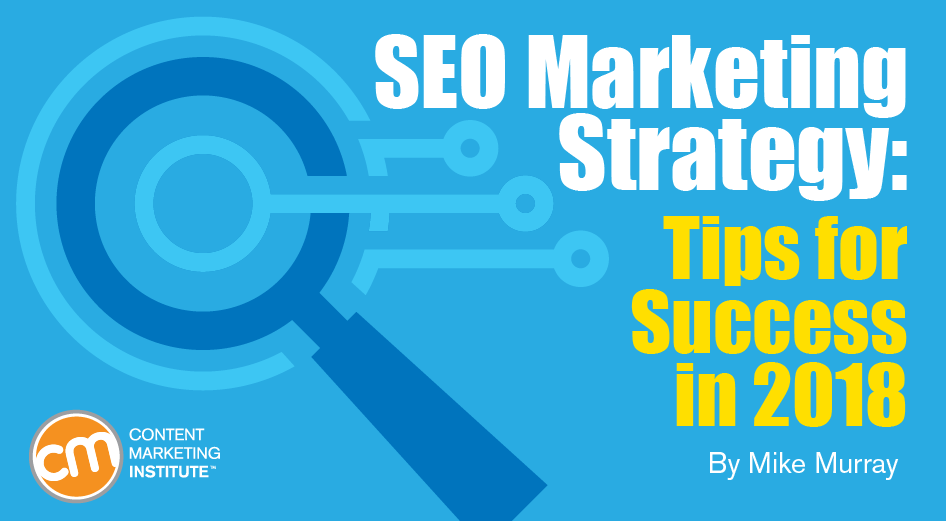
Businesses should use 2018 to break the bad habit of viewing aspects of an SEO marketing strategy as a one-time exercise. Too often, some companies optimize a website page and never adjust it.
Though 61% of marketers in a 2017 HubSpot study say increasing organic visibility is their highest inbound marketing priority, they don’t always follow through.
You can tell they don’t fully embrace an SEO strategy any time:
- SEO page titles lack a keyword focus.
- SEO page titles merely mimic the content headers.
- Page URLs are a mile long.
- Nothing is ever modified (take a quick look with the Wayback Machine, a popular archive of more than 300 billion web pages).
Now is a good time to take a closer look at SEO marketing data because search is getting worse for all types of B2B and B2C businesses.
Your keyword phrase that continues to rank No. 1 organically is no longer the top result seen by searchers because of design changes to Google’s search engine results pages (SERPs). That lack of visibility jeopardizes the effects of your organic traffic – leading to fewer clicks, leads, sales, page views, and conversions.
No. 1 organic ranking in Google no longer means it’s the top result seen, says @mikeonlinecoach. #SEOMarketing Click To TweetSERP elements (like videos or images) have been around for years, but they appeared intermittently. In the last couple of years, their use has intensified and shows no signs of slowing down.
Featured snippets are the summaries for the searcher’s query that appear at the top of the page (below the ads from Google AdWords).

The People also ask feature includes related queries to the original search phrase and is displayed on the front page of results.

Here are some other SERP elements:
- AdWords – up to four at the top with optional extensions can make each ad deeper
- Knowledge Graph – boxes that include data ranging from companies to celebrities on the right of search results page
- Sitelinks – multiple links to subpages within the website result visible below the primary website
- Local packs – several local listings appear together (often under a map marking the location of each one)
- Carousel listings – interactive visual display of results for things like movies, songs, and restaurants
- Reviews with star ratings (make some organic results deeper)
- Image packs – often a single row of images appearing on the results page
- Video
- In-depth articles
- Twitter content
To go more in depth on these elements, Moz has good tips on how to get your website included in the specialized SERP features. Search Engine Land touches on some of them as well and explains some other notable ranking trends, such as schema markup (instructions that help search engines understand types of content).
Even if your website isn’t included in SERP features as often as you would prefer, you still can work to improve your regular organic results by updating and/or expanding your content.
Use these three steps to make SEO updates.
Without trying too hard, larger enterprises can rank for many keywords because they’re credible in the eyes of search engines (the number of pages and backlinks help). Unfortunately, too many businesses don’t make enough updates to exploit their potential. They’re like a smart student who is a constant underachiever.
Too many businesses don’t make #SEO updates to exploit their content’s potential, says @mikeonlinecoach. Click To Tweet1. Find your SEO sweet spot based on data; set realistic expectations
You can target any keyword or phrase, but you face two primary challenges. The word may be too competitive or not searched, which would offer little to no value for your business.
Use a tool like SEMrush to better understand what keywords would be reasonable to pursue.
Use a tool like @SEMrush to better understand what keywords to pursue for your #content, says @mikeonlinecoach. Click To TweetAlso, look at how your website ranks for your keywords today. For example, does it typically rank in the top five positions for a keyword searched an average of 500 times a month on Google? What about searches conducted 1,000 times or more?
A thorough review allows you to size up trends and see potential sweet spots by recognizing how existing keywords perform – their ranking position in relation to search volume.
Here’s the thing: Set realistic expectations. It doesn’t make sense to pick a relevant keyword with 2,000 searches a month and expect a top ranking if you can’t crack the top 30 for keywords with only 1,000 searches a month.
It doesn’t make sense to pick a keyword w/ 2K searches a month & expect a top ranking. @mikeonlinecoach Click To TweetOr maybe your targeted keyword averages 50 searches a month. That may be OK, depending on what you sell and how many leads you need to get to a sale.
No matter the number of searches, you can improve rankings more quickly by forgoing the giant leap (in most cases) to No. 1. Target a keyword phrase where, for example, your site ranks eighth and take steps to push it to No. 5. Or choose a keyword phrase where your site is in the 12th position and work to make it appear in the seventh spot.
Although SERP design changes mean that moving to the fifth or seventh result won’t have as big of an effect like a few years ago, higher rankings are still important.
TIP: Some marketers don’t pay attention to keywords because they think Google values the ideas in content more than the keywords. In my experience, keywords are as essential as quality content.
I dug into the data for two companies – Grainger and Proto Labs (I’m not affiliated with either). I used the Moz authority score (1-100), which suggests how well a website page will rank based on the number and quality of inbound links and related factors. Grainger’s domain authority was 79, while Proto Labs was 56 – respectable numbers for both.
Grainger appears to do well with many keywords, including “pneumatic cylinders,” one of the many products it sells. Given the rankings and search volume, SEO can drive considerable traffic and leads for Grainger. Although some search volumes seem low, all of the keywords can help Grainger connect with buyers (some of whom may make bulk purchases).

Proto Labs’ page has some decent rankings, but too many keywords fall short and aren’t on the first page of Google’s search results. It would likely need to rank higher for many of the keywords to generate more interest in the company’s 3D printing services.
The results also underscore the value of creating new content with your SEO marketing strategy. Proto Labs may want to create a page for “3D printing for mold making” or even “plastic molds” to better introduce prospects to the company and its insights on the topic.

2. Tweak your SEO page titles
Are your keywords at the beginning of the SEO page title? Are you consuming precious space with your company name? Including your business in the SEO page title is certainly a good way to reinforce your brand – if the SEO page title appears on the SERPs. But is the presence of those words jeopardizing your ability to rank?
Including company name in #SEO title may jeopardize the page’s ability to rank, says @mikeonlinecoach. Click To TweetFor a company like Sears, the name is short so its inclusion is not an issue. But for a company like Proto Labs, its name could be problematic. For example, one page uses this SEO page title – Proto Labs: Choose a Rapid Manufacturing Services.
Essentially, the company is telling search engines that it wants to rank for “Proto Labs: Choose a Rapid” because those are the first few words.
To do better in search, this manufacturing services summary page’s title could be: 3D Printing, CNC Machining, and Injection Molding Manufacturing Services.
It’s not an ideal SEO page title because of the multiple distinct services, but the structure may give rise to rankings for some long-tail keyword phrases.
I go into much more detail in SEO Page Titles: 15-Point Checklist for B2B and B2C Brands, which explains the best ways to work in relevant keywords that accurately reflect the page content.
3. Explore other options that support SEO keywords
You need to strike a balance with page design, clarity, and SEO strategy. You don’t want to ruin content with keyword stuffing. But there often are opportunities to naturally work in your primary keywords and close variations:
- Revise content headers (headlines) with relevant keywords and include H1 tags.
- Add captions with images.
- Rename images.
- Add or update image alt text.
- Create internal links from other popular pages on your website.
- Add more text to thin pages that have few words.
- Pursue inbound links from other websites.
HANDPICKED RELATED CONTENT:
Create new content (and revise it over time)
When you create new content based on your priority keywords, you have several advantages with an SEO marketing strategy. An existing page may rank 20th for a keyword, but a new page may rank third. Work the keyword phrase into the SEO page title, content header, image, image alt text, etc.
All sorts of keyword phrases can be triggered by the content you create. You may have a couple keywords in mind. But a few months later, analyze that page through SEMrush and you may see other keywords for which that page ranks well.
For example, maybe you targeted “bulk bag filling equipment” and find out the page also ranks well for “bulk bag filler frame” – a phrase that is beneficial to your business. Continue to make adjustments to help that keyword phrase rank even higher.
TIP: New content also is a way to ensure that one page isn’t vying for too many keyword phrases. If you try to optimize too many keywords on a page, you risk hurting the rankings your page already achieved. If I see a few good words rank in the top 10 positions, I’m satisfied.
What else is at stake in SEO marketing in 2018?
SEO experts play up all sorts of variables, but not all variables have the same weight. Content and inbound links trump everything all the time. But, collectively, the smaller ranking factors are worth monitoring, fixing, and measuring.
Website design, technical considerations, and sufficient responses to questions (i.e., voice search) can all help your keywords rank better. Important factors to consider include:
- Mobile-first
- Page load speed
- Voice search
- Machine learning and AI
- Traffic and engagement metrics
- HTTPS encryption
For more about ranking factors, check out these guides from SEMrush, Searchmetrics, and MOZ.
The biggest companies don’t need to get everything right to do well with SEO. For example, some businesses miss the mark with SEO and images, and still rank well.
But it’s puzzling why some businesses don’t try harder with analysis, revisions, and new content with their SEO marketing strategy. It’s a great opportunity for smaller companies to nail down as many SEO best practices as possible.
Regardless of the effort, you can expect a tough road ahead. You’ll always have an organic presence. It’s just a matter of whether your visibility erodes and how well prepared you are to respond quickly to the evolving world of SEO.
What steps do you take to maximize your old and new content for SEO?
One step you can take in 2018 to improve your content marketing – including your SEO efforts – is to learn from hundreds of expert presenters at Content Marketing World this September. Register today.
Cover image by Joseph Kalinowski/Content Marketing Institute

